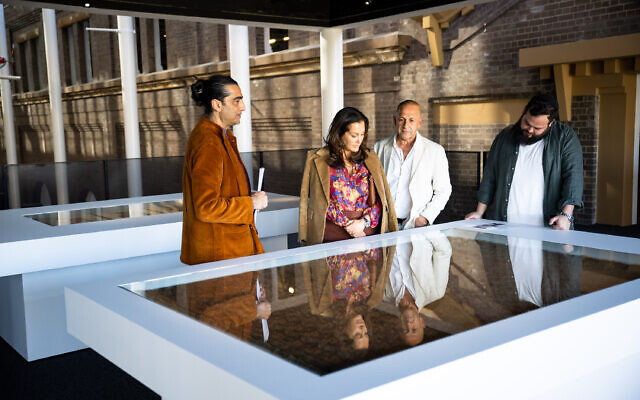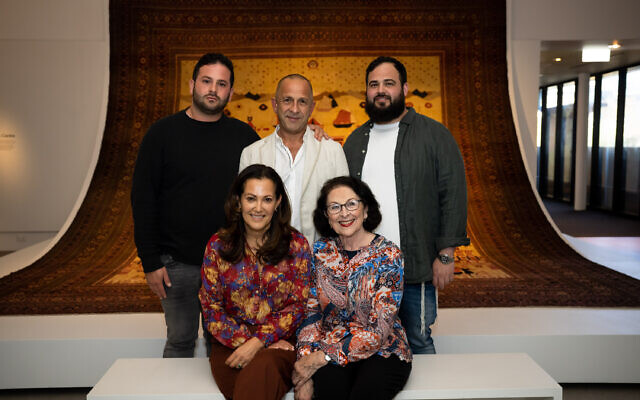Bringing a bit of Persia to Australia
Jacques Cadry used to say “history gleaned from textbooks is often dry and unimaginable”, so artwork is a beautiful way to discover stories. That philosophy is now being shared in various exhibitions, celebrating 70 years of Cadry’s – Sydney’s first Persian-owned carpet business.
ARTWORK is highly personal. When you choose an artwork for your home, you’re choosing to display the story behind it – the story of the artwork and the story behind the purchase of the artwork. The same goes for a rug. Which is something that Jacques Cadry was always passionate about.
Jacques grew up in Tehran. His family were in the rug trade; they had been deal- ing in rugs and carpets since the 19th cen- tury. While he found himself in the family steel pipe business working across Iran and the UK, a business trip to Australia changed the course of his life.
“He fell in love with Australia and decided he wanted a fresh start, and a country that would give his family better opportunities in life,” Jacques son Bob told The AJN. Jacques arrived in 1951 and by 1952 he had opened Cadry’s – a rug business that became an icon of Sydney fashion and retail.
It was also a business that brought all the ancient family knowledge for hand-knotted Persian rugs to Australia.
For Jacques, Cadry’s was as much about educating the public as it was about selling rugs. “Back then, people didn’t really understand a lot about rugs,” Bob explained. “Jacques really pioneered an education, to give people an understanding about the value and the lasting quality of handmade rugs.”
To celebrate the business’ 70th anniversary, artefacts and rugs from the family’s expansive personal collection will be on show at the Sydney Jewish Museum and at the Powerhouse Museum.
Weavers, Merchants and Kings at the Powerhouse is being curated by Professor Pedram Khosronejad, who recalled his first meeting with the Cadry family.
Pedram explained that when he started at the Powerhouse, he stumbled upon the richness of the Persian collection, which he says includes thousands of objects from Persia, Iran and the greater Persian society, and neighbouring countries. He suggested that the museum showcase Persian arts and crafts for the first time as an exhibition, and during research for this, he stumbled upon the name of Cadry. When he called Bob to discuss the opportunity, he was immediately welcomes into the showroom and treated like an old friend.
“It was a very emotional moment,” Pehram explained. “I didn’t know who they were, and they didn’t know who I was, I told my story, they told theirs.” It was the start of the curation of the exhibition.
Pedram also spoke about the impact Jacques had on those around him.
“When Jacques Cadry opened his showroom in 1952, it was, in my idea, like a college. If Jacques could, he wanted to create in his showroom the Faculty of Persian and Orientalist Studies,” Pedram said. “Every week … [the showroom] was a classroom for everyone to learn, have a tea, discuss Persian culture, Persian art, Islamic art.”
The hope is that Weavers, Merchants and Kings will expose a whole new generation to the stories and traditions of Persia and its surrounds.
In a world first, an antique Persian Dorokhsh carpet will be displayed. The carpet is believed to have been created for a royal palace and is on loan from Cadry’s. It is one of only a handful of examples known to feature an architectural scene as the central design and provides a rare glimpse into a period of Indo-Persian history during the late 19th century.

“It’s probably the biggest Persian pictorial carpet in the world,” Pedram said. “What makes it special is the iconography and imagery that we have in the middle of the carpet, which depicts the sky full of stars, the sun to the moon, the mountains of Persia and the Persian Gulf with some boats, and then it comes to India and beautiful Islamic architecture.”
Persian Dorokhsh carpets revived ancient textile-making traditions in Khorassan, a region renowned for woven art, and transformed the nomadic craft of carpet-weaving into a specialised artisan industry.
While not all Persian carpets are this intricate, the Dorokhsh carpet shows just how much a rug can tell a story.
“People weave what they see in their environments or what inspirations invigorate them,” Bob said. “Each one is a one-of-a-kind rug, there are no two exactly the same, yet fascinatingly, you can, with a reasonable amount of knowledge and experience, identify through the materials and similarities of the motifs, the regions or the tribes where each rug is made.”
It’s these stories that the exhibition is hoping to share.
The same goes for Woven Memory, which is currently on show at the Sydney Jewish Museum. Again, to celebrate the 70th anniversary of Cadry’s, the exhibition is showcasing a selection of rugs from the Cadry family collection, this time covering Jewish themes.
Both exhibitions, Bob says, are close to the family’s heart.
“[They’re] wonderful exhibitions that talk to the heart and soul of tradition, and for us, our traditional values are so important at a time when we are celebrating and proud of our heritage.”
Weavers, Merchants and Kings is at the Powerhouse Museum until January 2023. Woven Memory is currently at the Sydney Jewish Museum.


comments